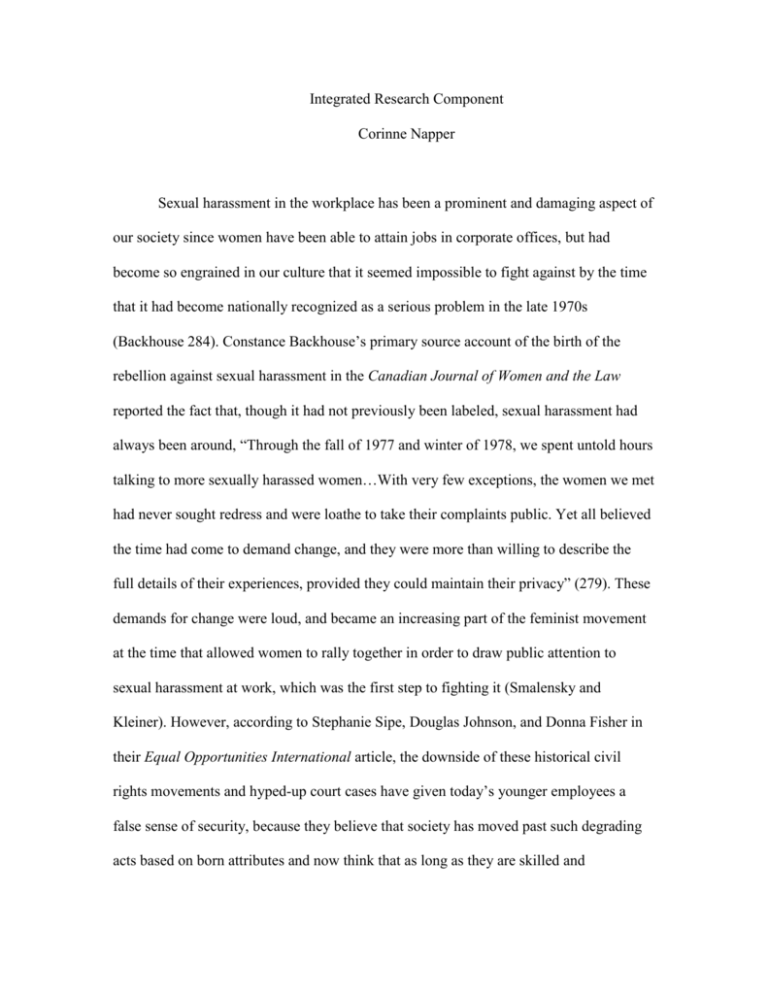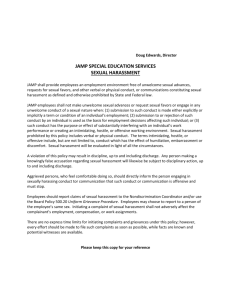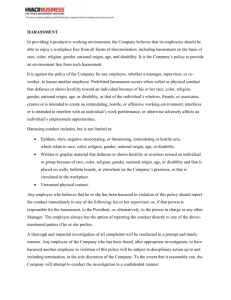Integrated Research Component final
advertisement

Integrated Research Component Corinne Napper Sexual harassment in the workplace has been a prominent and damaging aspect of our society since women have been able to attain jobs in corporate offices, but had become so engrained in our culture that it seemed impossible to fight against by the time that it had become nationally recognized as a serious problem in the late 1970s (Backhouse 284). Constance Backhouse’s primary source account of the birth of the rebellion against sexual harassment in the Canadian Journal of Women and the Law reported the fact that, though it had not previously been labeled, sexual harassment had always been around, “Through the fall of 1977 and winter of 1978, we spent untold hours talking to more sexually harassed women…With very few exceptions, the women we met had never sought redress and were loathe to take their complaints public. Yet all believed the time had come to demand change, and they were more than willing to describe the full details of their experiences, provided they could maintain their privacy” (279). These demands for change were loud, and became an increasing part of the feminist movement at the time that allowed women to rally together in order to draw public attention to sexual harassment at work, which was the first step to fighting it (Smalensky and Kleiner). However, according to Stephanie Sipe, Douglas Johnson, and Donna Fisher in their Equal Opportunities International article, the downside of these historical civil rights movements and hyped-up court cases have given today’s younger employees a false sense of security, because they believe that society has moved past such degrading acts based on born attributes and now think that as long as they are skilled and knowledgeable, they will be immune to sexual harassment. This view is naïve because even though the US Supreme Court recognized sexual harassment as a cause of action under Title VII 2 decades ago, sexual harassment is still often occurring and swept under the rug in today’s offices (Sipe, Johnson, and Fisher). The historically negative effects of sexual harassment in the workplace and the current effects are strikingly similar. In Joan Abramson’s book, Old Boys New Women: The Politics of Sex Discrimination, she strings together historical court cases on sexual harassment in the workplace, including the very first one. Lella Smith Candea was the first woman to file a successful sex discrimination complaint in 1971 after years of harassment, but she suffered a great amount of backlash as a result of her action, including losing her office and being relocated to a broom closet, within 24 hours of her filing it (152). Such struggle is still happening today, often without formal complaint, and is severely damaging to both the victim and the company that they work for. Sexual harassment is often perceived as an individual and personal problem, not a problem of the company as a whole, but it actually does take away from the victim’s productivity no matter how skilled they are, and also serves as a distraction to many otherwise productive employees (Havemann). Judith Havemann’s article, “Evaluating Sexual Harassment in the Workplace; Education on the Subject ‘A Low Priority’ Despite Survey Finding Widespread Complaints,” published in The Washington Post in 1988, frequently attests that sexual harassment, even without filing a formal complaint, damages the victim’s career by devaluing her skill and productivity in the workplace as well as hurting her chance for a promotion, because even if she is very skilled it becomes clear that her associates do not take her seriously enough for her to be considered for a raise. Similarly, Sipe, Johnson, and Fisher’s study of sexual harassment in Equal Opportunities International shows that sexual harassment in the workplace can result in the victim's decreased job satisfaction, withdrawal from work, less organizational commitment, ill health and some symptoms of post-traumatic stress disorder for individuals, as well as lower productivity, increased absenteeism and increased sick leave costs for organizations, which shows that it is mutually beneficial for these companies to be investing in sexual harassment education, treatment, and recovery. Education and training on sexual harassment in the workplace seems obvious in order to stop these horrible negative affects, but real training on what this harassment actually is has been startlingly hard to find even after the 1970s, when attention was first drawn to the issue. Agencies and corporate offices are have only been concerned with the productivity and dollar of their company since their establishment in our society (Havemann). Training for sexual harassment education is not a priority in agencies because most offices feel as if this education is not directly linked to productivity, like skill training is (Havemann). However, this way of thinking is mistaken in that, as shown in the previous paragraph, sexual harassment in the workplace can cause a downfall in the productivity of employees. An increase in morale means an increase in productivity, which means more output and dollar value (Colquitt and Kleiner). The inverse must also be true. When Judith Havemann interviewed Frederick A. Miller, president of Kaleel Jamison Associates, he identified that often the lack of education on sexual harassment keeps both victims and perpetrators from understanding that it is occurring, and makes an effort to clear up the definition, which he says “is something that happens to women in the workplace that prevents them from reaching their full potential that is not experienced by men.” If employees do not reach their full potential, neither does the company. Yet, so many managers, supervisors, and company owners have yet to grasp that their companies are comprised of individuals whose behavior affects their output. The lack of formal complains from victims of sexual harassment in the workplace is derived from both the negative affects on their career and the apathy by their companies to help them with what has been deemed an individual problem. Judith Haveman quotes miller in her interview with him to get some perspective on the mentality of those in charge of a corporation, “‘If someone in your office stole money and you reported it, it would be taken out of your hands and pursued by the company because that's who it harms,’ he said. ‘With sexual harassment, you're on your own, it's your word and your reputation against theirs -- a lot of women just feel it isn't worth the hassle to report it.’” If we as a society are able to overcome our apathy and our feelings of fear and resignation, sexual harassment in the workplace would be greatly diminished. These reactions have been seen since the beginning of the anti-harassment movement. “The terminology was new to many. The idea that women might collectively rebel against sexual harassment seemed to be beyond credulity. And even those who expressed deep frustration about sexual harassment, including feminists and leaders of women’s unions, seemed largely resigned to passivity” (Backhouse, 284). We overcame that initial passivity and the attention has been drawn to the issue at hand. Now our only option is to fight it. Bibliography Abramson, Joan. Old Boys--new Women: The Politics of Sex Discrimination. New York: Praeger, 1979. Print. This book was found using the VCU Library homepage and narrowing the search to print-only sources, then using the keywords “sexual harassment*” and “sexual discrimination*” [Corinne Napper] Backhouse, Constance. "Sexual Harassment: A Feminist Phrase That Transformed the Workplace." Canadian Journal of Women and the Law/Revue Femmes Et Droit 24.2 (2012): 275-300. Academic Search Complete. Web. 7 Oct. 2014. This article was found using a VCU Libraries Journal Search using the phrase “Sexual Harassment in the Workplace.” Colquitt, Brent, and Brian H. Kleiner. "How The Best Companies Are Preventing Sexual Harassment In The Workplace." Equal Opportunities International 15.3 (1996): 12-20. Web. This journal was found using the VCU Libraries discipline-specific database Genderwatch, using the search terms “Sexual Harassment in the Workplace.” [Corinne Napper] Havemann, Judith. "Evaluating Sexual Harassment in the Workplace;Education on the Subject `a Low Priority' Despite Survey Finding Widespread Complaints." The Washington Post. N.p., 4 July 1988. Web. 10 Oct. 2014. This article was found using LexisNexis Academic using the search terms “Sexual Harassment in the Workplace” and filing the results from oldest to newest. [Corinne Napper] Sipe, Stephanie R., C. Douglas Johnson, and Donna K. Fisher. "University Students' Perceptions of Sexual Harassment in the Workplace: A View through Rosecolored Lenses." Equal Opportunities International 28.4 (2009): 336-50. Web. This journal was found using the VCU Libraries discipline-specific database Genderwatch, using the search terms “Sexual Harassment in the Workplace.” [Corinne Napper] Smalensky, Elizabeth, and Brian H. Kleiner. "How to Prevent Sexual Harassment in the Workplace." Equal Opportunities International18.2/3/4 (1999): 3-7. Web. This journal was found using the VCU Libraries discipline-specific database Genderwatch, using the search terms “Sexual Harassment in the Workplace.” [Corinne Napper]









